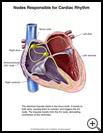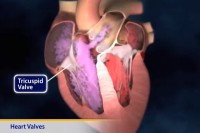
Wolff-Parkinson-White Syndrome
What is Wolff-Parkinson-White Syndrome?
Wolff-Parkinson-White (WPW) syndrome is a condition in which there is an extra electrical connection between the upper chambers of the heart (the atria) and the lower chambers of the heart (the ventricles).
Normally, electrical signals use only one pathway when they move through the heart between the atria and ventricles. This pathway is called the atrioventricular or AV node. As the electrical signal moves through the lower chambers, it causes the heart to beat. The electrical signal must be coordinated in order for the heart to contract (beat) properly.
In WPW, the extra electrical connection between the upper and lower chambers may cause a short circuit. With this short circuit, the heart beats very quickly. Instead of its normal rate of 70 to 80 beats a minute, it may beat over 200 times a minute. The fast heartbeat is called supraventricular tachycardia (SVT).
How does it occur?
Some people are born with this extra pathway. No one knows what causes it. It may cause symptoms as early as the first year of life or not until as late as age 60.
What are the symptoms?
Your child may have no symptoms. The heartbeat may get very fast and cause your child to:
- be lightheaded, weak, or dizzy
- be short of breath
- sweat
- have chest pain.
Your child may also have palpitations (a pounding heartbeat) or an irregular heartbeat.
In general, WPW syndrome is not life threatening. Rarely, a child may develop atrial fibrillation (the upper part of the heart beats or quivers faster than the rest of the heart). The heart may beat so fast that it stops pumping completely.
How is it diagnosed?
Your child’s healthcare provider will ask about your child’s medical history and do an exam. Some of the tests that may be done are:
- echocardiogram, which uses sound waves to create pictures of the heart (an ultrasound scan)
- electrocardiogram (ECG or EKG), which is a recording of the electrical activity of the heart
- an electrophysiology study to measure the speed of an electrical impulse traveling through the system
- angiogram, which uses X-ray pictures of dye injected into a blood vessel to look inside the heart and blood vessels
- MRI (magnetic resonance imaging), which uses magnetism, radio waves, and a computer to make pictures of the heart and blood vessels
If the fast heartbeat comes and goes, your child may need to wear a Holter monitor during daily activities. A Holter monitor is a small device that records the electrical activity of the heart.
How is it treated?
If your child is not having serious symptoms, your child may not need treatment.
Fast or irregular heartbeats can often be treated with medicine. If your child has severe and frequent symptoms, your child may have a procedure known as radiofrequency ablation. In this procedure, a thin, flexible tube called a catheter is placed in the heart through a vein or artery in the groin. The catheter is guided to the extra pathway. The extra pathway is destroyed with a low-energy electrical current. Ablation usually cures this disorder.
Last modified: 2011-07-21
Last reviewed: 2011-06-06


